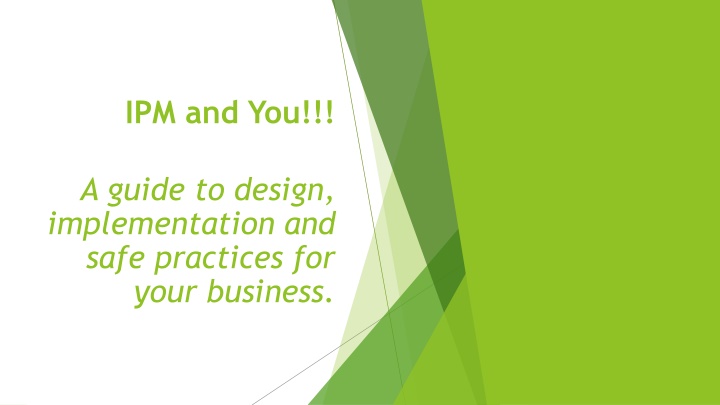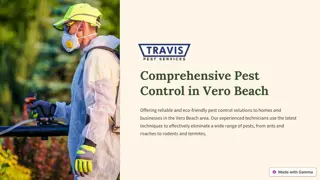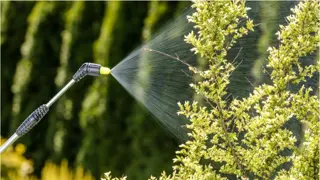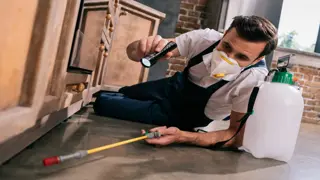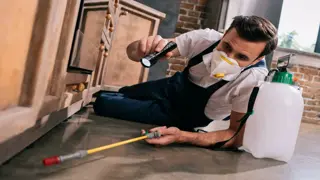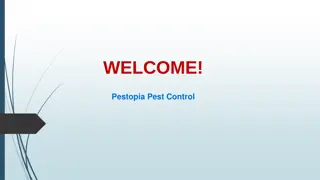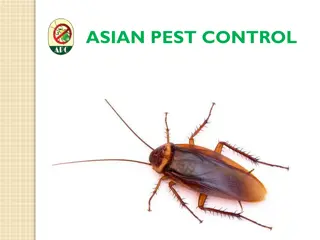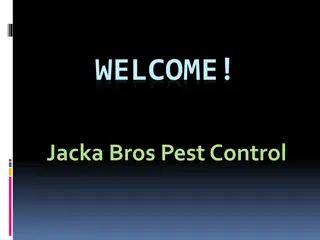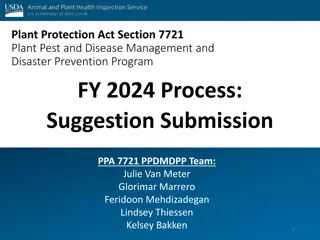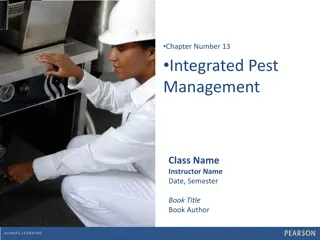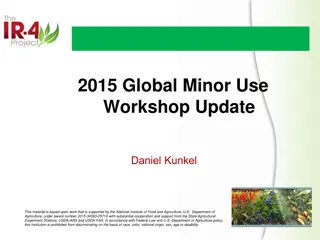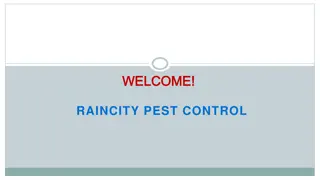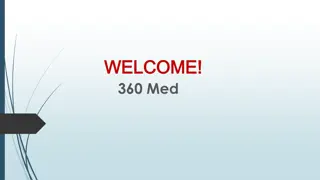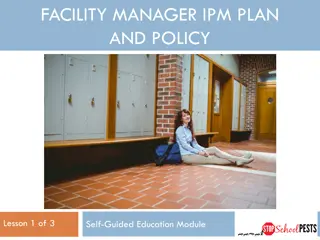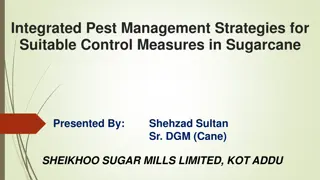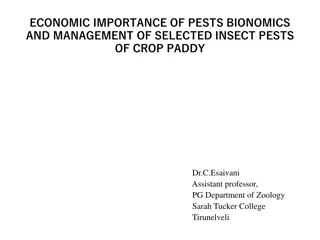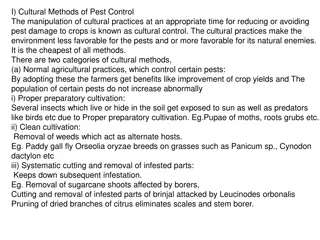Implementing Integrated Pest Management: A Comprehensive Guide
"Guide to implementing Integrated Pest Management (IPM) for businesses, focusing on effective pest solutions while minimizing risks to people and the environment. Learn practical strategies and safe practices for successful pest management."
Download Presentation

Please find below an Image/Link to download the presentation.
The content on the website is provided AS IS for your information and personal use only. It may not be sold, licensed, or shared on other websites without obtaining consent from the author.If you encounter any issues during the download, it is possible that the publisher has removed the file from their server.
You are allowed to download the files provided on this website for personal or commercial use, subject to the condition that they are used lawfully. All files are the property of their respective owners.
The content on the website is provided AS IS for your information and personal use only. It may not be sold, licensed, or shared on other websites without obtaining consent from the author.
E N D
Presentation Transcript
IPM and You!!! A guide to design, implementation and safe practices for your business.
Integrated pest management, or IPM, is a process you can use to solve pest problems while minimizing risks to people and the environment. IPM can be used to manage all kinds of pests anywhere in urban, agricultural, and wildland or natural areas. Definition of IPM IPM is an ecosystem-based strategy that focuses on long-term prevention of pests or their damage through a combination of techniques such as biological control, habitat manipulation, modification of cultural practices, and use of resistant varieties. Pesticides are used only after monitoring indicates they are needed according to established guidelines, and treatments are made with the goal of removing only the target organism. Pest control materials are selected and applied in a manner that minimizes risks to human health, beneficial and nontarget organisms, and the What Is Integrated Pest Management (IPM)?
What is a pest? Pests are organisms that damage or interfere with desirable plants in our fields and orchards, landscapes, or wildlands, or damage homes or other structures. Pests also include organisms that impact human or animal health. Pests may transmit disease or may be just a nuisance. A pest can be a plant (weed), vertebrate (bird, rodent, or other mammal), invertebrate (insect, tick, mite, or snail), nematode, pathogen (bacteria, virus, or fungus) that causes disease, or other unwanted organism that may harm water quality, animal life, or other parts of the ecosystem.
How Does IPM Work? IPM focuses on long-term prevention of pests or their damage by managing the ecosystem With IPM, you take actions to keep pests from becoming a problem, such as by growing a healthy crop that can withstand pest attacks, using disease-resistant plants, or caulking cracks to keep insects or rodents from entering a building. Rather than simply eliminating the pests you see right now, using IPM means you'll look at environmental factors that affect the pest and its ability to thrive. Armed with this information, you can create conditions that are unfavorable for the pest.
In IPM, monitoring and correct pest identification help you decide whether management is needed Monitoring means checking your field, landscape, forest, or building or other site to identify which pests are present, how many there are, or what damage they've caused. Correctly identifying the pest is key to knowing whether a pest is likely to become a problem and determining the best management strategy. After monitoring and considering information about the pest, its biology, and environmental factors, you can decide whether the pest can be tolerated or whether it is a problem that warrants control. If control is needed, this information also helps you select the most effective management methods and the best time to use them.
IPM programs combine management approaches for greater effectiveness The most effective, long-term way to manage pests is by using a combination of methods that work better together than separately. Approaches for managing pests are often grouped in the following categories.
Biological control Biological control is the use of natural enemies predators, parasites, pathogens, and competitors to control pests and their damage. Invertebrates, plant pathogens, nematodes, weeds, and vertebrates have many natural enemies.
Cultural controls Cultural controls are practices that reduce pest establishment, reproduction, dispersal, and survival. For example, changing irrigation practices can reduce pest problems, since too much water can increase root disease and weeds.
Mechanical and physical controls Mechanical and physical controls kill a pest directly, block pests out, or make the environment unsuitable for it. Traps for rodents are examples of mechanical control. Physical controls include mulches for weed management, steam sterilization of the soil for disease management, or barriers such as screens to keep birds or insects out.
Chemical control is the use of pesticides. In IPM, pesticides are used only when needed and in combination with other approaches for more effective, long-term control. Pesticides are selected and applied in a way that minimizes their possible harm to people, nontarget organisms, and the environment. With IPM you'll use the most selective pesticide that will do the job and be the safest for other organisms and for air, soil, and water quality; use pesticides in bait stations rather than sprays; or spot-spray a few weeds instead of an entire area. Chemical control
The Six IPM Program Essentials Monitoring. This includes regular site inspections and trapping to determine the types and infestation levels of pests at each site. Record-Keeping. A record-keeping system is essential to establish trends and patterns in pest outbreaks. Information recorded at every inspection or treatment should include pest identification, population size, distribution, recommendations for future prevention, and complete information on the treatment action. Action Levels. Pests are virtually never eradicated. An action level is the population size which requires remedial action for human health, economic, or aesthetic reasons. Prevention. Preventive measures must be incorporated into the existing structures and designs for new structures. Prevention is and should be the primary means of pest control in an IPM program. Tactics Criteria. Under IPM, chemicals should be used only as a last resort only, but when used, the least-toxic materials should be chosen, and applied to minimize exposure to humans and all non-target organisms. Evaluation. A regular evaluation program is essential to determine the success of the pest management strategies
Least Toxic Pesticides (as defined by Beyond Pesticides) Least toxic pesticides include: boric acid desiccant dusts (diatomaceous earth and silica gel) nonvolatile insect and rodent baits in tamper resistant containers or for crack and crevice treatment only, microbe-based pesticides, pesticides made with essential oils (not including pyrethrums) without toxic synergists; and, materials for which the inert ingredients are nontoxic and disclosed. The term 'least toxic pesticides' does not include a pesticide that is: determined by EPA to be a possible, probable, or known carcinogen, mutagen, teratogen, reproductive toxin, developmental neurotoxin, endocrine disruptor, or immune system toxin; a pesticide in EPA's toxicity category I or II; and any application of the pesticide using a broadcast spray, dust, tenting, fogging, or baseboard spray application.
Benefits of IPM Economists and IPM researchers have worked for decades to develop methodology to assign a dollar value to the use of IPM technologies in agriculture. It has thus far been difficult to extract an exact dollar figure as to the cost savings of IPM implementation, although there has been general unanimous agreement that dollar savings are significant. Considering the cost of chemical pesticides and their application, even the reduction of one pesticide application can amount to a considerable reduction in pest control costs.
IPM offers several benefits. It helps to: Reduce the number of pests. Reduce the number of pesticide applications. Save money while protecting human health.
Adopting IPM reduces exposure to both pests and pesticides. Two health concerns faced throughout the country by children and adults are: Allergies. Asthma. Rodents, cockroaches, and dust mites are often present in buildings and can cause or inflame serious allergic reactions and asthma attacks. Studies in New York City Revealed a significant association between the prevalence of asthma among children and adults, and the incidence of pests, allergens (high cockroach and mouse allergen levels) and pesticides found in public housing; and Demonstrated the effectiveness of IPM in controlling these allergens. While pesticides can play a key role in IPM programs, by their very nature most pesticides pose some risk. They are powerful tools for controlling pests but need to be used carefully and judiciously.
There are cost savings associated with using IPM. IPM may be more labor intensive than conventional pest control and may require more up-front resources. However, costs are generally lower over time because the underlying cause of the pest problem has been addressed. IPM practices also provide financial benefits unrelated to pests. For example, weatherization of buildings not only excludes pests but also saves energy and reduces moisture problems. Integrated pest management offers many benefits for schools, including: Fewer pests. Fewer pesticide applications. Money savings. Improved environmental health.
However, IPM does have some disadvantages. These include: -more involved planning -more family decision-making -more demanding lawn and garden care -more resources needed as substitutions for pesticides -requires a greater amount of outside knowledge
Steps for creating an IPM Plan for your Business
STEP 1: Developing an Official IPM Policy Statement The transition from a conventional pesticide program to an IPM program goes beyond simply stating a commitment to support and implement an IPM approach. An official IPM policy statement acts as a guide for the IPM coordinator to use in developing a specific IPM program. This policy statement should state the intent of the leadership and administration of your business to implement an IPM program. It should briefly explain what is expected, the incorporation of existing services into an IPM program, and the education and involvement of your staff.
STEP 2: Identifying Roles and Responsibilities Communication among those involved in a pest management system is the key to the success an IPM program. When the respective roles of everyone in the IPM program are identified and agreed upon, and when these people communicate with each other, more effective and less expensive protection of the site can be achieved with reduced risk to the environment and its occupants. The IPM program should be incorporated into existing school or day care staff responsibilities. Examples of IPM functions and responsibilities are:
Generally, persons who authorize the pest management program and control expenditures for pest management are those involved in the direct management (or administration) of the facility, the purchasing agent , Environmental Services Depart, or Engineering Department are often key decisionmakers in this process. At this level of pest management decision-making, concerns about costs, liability, time expended, method effectiveness, safety and customer or occupant satisfaction are foremost. These decision-makers also determine if pest management objectives are being met. Management must hold staff, occupants, and contractors accountable for their actions or inaction involving all aspects of pest management. One way this can be done is by monitoring complaints from occupants and/or by observation of the site environment. Decision-makers also must provide the necessary level of financial commitment for any IPM program to succeed. It is important for upper management to communicate their commitment to the IPM program and to support the staff in their efforts to implement all aspects of the IPM Plan.
Maintenance Staff: Proper building maintenance is essential to good pest control. Maintenance staff should be aware of their role in preventing pest infestations and supported in their efforts. Maintenance plays such an important role in the IPM program that a facility may want to consider making the maintenance supervisor the IPM coordinator. Building repairs, sealing, screening, proper landscaping, and preventive maintenance can drastically reduce the number of pests found in a facility and make actions taken against pests more effective. The maintenance staff, at a minimum, needs to be aware of IPM procedures so they can facilitate the IPM process and work successfully with the IPM coordinator to eliminate pest problems.
Food Service Personnel: Most pest infestations in school and day care facilities occur in and around food preparation and storage areas. A commitment to proper sanitation, storage and inspection practices is essential for pest management in food preparation areas. If sanitation procedures are already in place, review them to ensure all elements of IPM have been addressed and incorporated into your IPM plan. An inspection procedure should be written and followed to address issues in an appropriate and timely manner. It is critical that food service personnel report pest sightings immediately.
STEP 3: Setting Integrated Pest Management Objectives for Sites: Pest management objectives differ between sites; therefore, a site s objectives and pest tolerance must be considered before establishing action threshold levels. Facilities should outline specific objectives in a pest management plan, such as: Prevent interference with the work environment of the employees; Preserve the integrity of the building(s). Decisionmakers should ensure that objectives are obtainable and realistic. For instance, a statement such as remove all pests from buildings is unrealistic and unattainable. Alternatively, remove all cardboard boxes following routine shipments is realistic and attainable.
STEP 4: Determining Tolerance or Action Thresholds of Pest Activity A tolerance or action threshold is the point at which action is initiated for a given type of pest. It is determined by deciding how many pests can be tolerated and by the danger or public health threat posed by the pest. Action thresholds are set by agreement with the provider and the facilty management and should reflect the site s pest management objectives. Remember, the presence of a pest does not necessarily require application of pesticides, but when pest populations exceed action thresholds, some corrective action should be taken. Customized recommendations to achieve specific results are an essential part of an IPM program. Custom recommendations, including an explanation of the benefits, should be based on the evaluation of available data obtained through inspecting, identifying and monitoring. Determining tolerance or action thresholds along with response times is one of the keys to a successful IPM program.
STEP 5: Determining Response Times Response to pest problems must be timely, consistent, and effective; however, the facility staff must recognize that some pest problems are more serious than others. For example, the control of a pest that threatens the safety of staff should have a higher priority than the mere presence of a single non-threatening insect. Consequently, the facility management and pest control contractor must agree on the response times for pests.
STEP 6: Developing Outlines for Specific Pests. The IPM program should contain specific outlines as a guide to properly identify and manage specific pests. The outlines contain information on life cycles, breeding habits, favored habitats, conditions conducive to infestation, and treatment strategies for the pest. Furthermore, pest outlines should be from an authoritative source such as a university extension service or public health department
STEP 7: Establishing Periodic Inspection: Monitoring and Reporting System: Periodic and thorough inspection of key areas combined with the evaluation of staff pest sighting reports are critical to a successful IPM program. All other IPM actions build upon this foundation. A structural pest control technician should do the inspections. This person must: identify or obtain an accurate identification of any specimen; know the life cycle and habits of pests most likely found at the facility know where the signs of pests are most likely to be found in the facility be familiar with the many ways pests enter the facility have access to all areas of the facility talk to the staff person who filed the pest sighting report, evaluate the information, and make a decision on any subsequent action to be taken be familiar with pesticide safety procedures and respond to emergency situations as needed make written recommendations for upgrading of the facility and for changing procedures to diminish the entry of pests and/or to find harborage areas in the facility; note and provide corrective actions for potential pest problem and harborage areas including water and food sources follow up on the recommendations and/or changes in procedures to confirm that they have been completed provide a detailed written report for each month.
Routine inspection and accurate identification of pests are vital steps in IPM to ensure the effectiveness of control methods. Once a pest has been identified and the source of its activity pinpointed, actions such as habitat modification, primarily exclusion, repair and sanitation, can greatly reduce pest prevalence. Monitoring includes inspecting areas for pest evidence, entry points, food, water and harborage sites, and estimating pest population levels. This can be achieved using sticky traps, and physically observing pests or evidence of pests such as droppings, nests, or shed skins (exoskeletons). The information gained through monitoring is evaluated to determine whether the action threshold has been exceeded and what management methods will be employed. A monitoring program should be outlined in the IPM plan to include who will be performing the monitoring, when and where the monitoring will take place, and how the monitoring will be performed
Reporting Staff members also need a way to report pest problems between inspection periods. A pest reporting procedure should be outlined so that staff members can promptly report pest sightings. The reporting form should be concise and require specific information so that the staff are not overburdened by a long form and the IPM provider is not inundated with extraneous information. The pest sighting report form should be filed with the IPM provider for investigation and possible corrective action. Again, if an IPM program is to succeed, response to a pest problem must be timely, consistent, and effective.
STEP 8: Following up, Evaluating, and Record Keeping Following up Inspecting and Evaluating to continually update the IPM plan: follow-up inspections must be completed and evaluated. Evaluations must be documented and the plan updated to prevent mistakes or failures from recurring. The IPM plan is a dynamic, constantly changing document and it is the evaluation of IPM procedures that allows the IPM provider to improve the plan. Consequently, all aspects of the facility's pest management program must be periodically reviewed to determine if pest problems are chronic or temporary. If a pest problem occurs repeatedly over a three-month period and several pest management techniques have been tried, the problem may be chronic. For example, mice repeatedly seen in the same area suggests they are entering from a harborage area like a hidden crawlspace. In contrast, temporary or seasonal problems may occur about the same time each year, but usually disappear in a few days.
The IPM program review or evaluation also can be used to determine if previous problems have been eliminated and if new problems are appearing or reappearing. Other changes in the facility's operations can affect the functioning of the IPM program, such as: differences in use patterns like the addition of shifts or changing working hours nearby excavation and construction causing an invasion of rats or American Cockroaches; seasonal invasion of mice from nearby fields following grain harvest; and high fly numbers from decaying material deposited by a recent flooding event. It is important that communication between the facility management and the IPM provider remain open in order to avoid misconceptions associated with the IPM program. The IPM program review or evaluation can open the lines of communication between all parties and outline successes and failures as well as the overall objectives of the program.
Record Keeping A successful IPM program relies on accurate record keeping. It provides the documentation needed for the school to evaluate the results of current IPM practices to 12 determine if pest management objectives have been met or if new objectives need to be established. Keeping accurate records also leads to better decision making and more efficient procurement. By keeping accurate records, results can be recorded showing actions taken in correlation to pest population reduction.
A complete and accurate pest management log should be maintained for each property and kept with the IPM plan. Pesticide application records also should be maintained in order to keep a historical account of pesticides used. The logbook should contain the following items: inspection sheets pest surveillance sheets that record the type and number of pests or other indicators of pest population levels revealed by the monitoring program for the site. Examples include: date, number, location, and rodent species trapped or removed, as well as date, number and location of rat burrows observed pest sighting forms and action taken a diagram noting the location of pest activity including locations of all traps, trapping devices and bait stations in or around the site a copy of the current EPA-registered label and current Material Safety Data Sheet (MSDS) for each pesticide product used, where they were used, and the amount used.
Cooperation is Key! As stated previously, an efficient IPM program starts with the support of all levels of management and staff and incorporates the facility activities related to pest management, such as preventive maintenance, janitorial practices, landscaping, and occupant/staff training. Other procedures should be reviewed for compatibility with the IPM program and, in some instances, be incorporated into the IPM plan. The IPM plan should contain a diagram of the facility so accurate records of pest activity, monitoring devices, and corrective action procedures can be accurately documented. A diagram also will ensure that no areas go unnoticed and can point out key pest entry points such as gaps around utility lines and under doors, cracks and holes in the structure, and unscreened vents, windows and doors.
Safety First!!!! A comprehensive listing of Personal Protective Equipment required to ensure worker safety in an IPM program
Personal Protective Equipment Pesticides can cause hazards to the health and safety of humans. Much of the hazard depends on the chemical makeup and formulation, its path into the body, the amount that enters the body, and the length of exposure. Wearing Personal Protective Equipment, or PPE , can greatly reduce the potential for dermal, inhalation, eye, and oral exposure, and thereby significantly reduce the chances of a pesticide poisoning.
PPE refers to clothing and devices worn to protect the human body from contact with pesticides or pesticide residues. PPE includes such items as protective suits, footwear, gloves, aprons, respirators, eyewear, and headgear. When purchasing and prior to using a pesticide product, it is essential that you read and understand all portions of the pesticide product label. You are legally obligated to follow the instructions and requirements on the label. The label is the law, AND it contains vital information about the use, safety and handling of the product. Carefully review the signal word, precautionary statements, personal protective equipment requirements, entry restriction statements, emergency first aid measures, and directions for use they are included to protect you, others, and the environment.
Different pesticide products require different personal protective equipment. Remember that any product that contains a pesticide including baits, aerosols, fertilizers, seed, natural products, etc. must be handled using the required PPE, in the correct way. In addition, there are basic PPE principles and practices that must be understood to protect the health and safety of everyone involved in handling a pesticide.
What to Consider When Selecting Different Types of Personal Protective Equipment Correct selection of PPE is the first critical step. Follow the pesticide product label carefully when certain types of gloves, respirators, and/or other PPE are specified. For example, a specific type of glove material may be highly chemical- resistant to some pesticide products but not others. A respirator suitable for one task may not be suitable for another. A water-resistant material is different than a chemical-resistant material.
Chemical-resistant PPE is material that allows no measurable movement of the pesticide being used through the material during use. However, chemical- resistant aprons, coveralls, eye protection, footwear, gloves, and headgear are not equally resistant to all pesticides, under all conditions, and for the same length of time.
Read the PPE user instructions carefully to ensure that the PPE meets the specifications on the particular pesticide product label. If in doubt about what PPE to use, call the pesticide product manufacturer, the PPE manufacturer, your county agent, or your state s pesticide safety education program. Pesticide labels, PPE instructions, and safety equipment catalogs contain phone numbers, and PPE manufacturer websites often contain detailed information on their products. More is not necessarily better in the case of PPE select the PPE required by the label.
Make Sure PPE is Working Properly It is very important to select the correct PPE. Just as important, the PPE must be working correctly every time you use it, either alone or in combination with other PPE. When several pieces of PPE are used together, they must not interfere with each other. For example, protective goggles must not interfere with the operation of a respirator. Read the PPE user instructions carefully before every use, and seek assistance if needed. Before and after every use, check for any type of deterioration of or damage to all the components, seams, etc. of the specific reusable PPE and, if necessary, dispose of properly.
Aprons, when required, must be made of chemical-resistant material and cover the front of the body from mid-chest to the knees. It is a good idea to wear an apron whenever mixing or loading chemicals or cleaning spray equipment, even when not required on the pesticide label.
Coveralls are loose-fitting one- or two-piece garments that cover, at a minimum, the entire body except the head, neck, hands, and feet. The pesticide label may specify that the coveralls be worn over a layer of clothing. Most coveralls are made of fabric such as cotton or a cotton-polyester blend and are not chemical-resistant. There are laminated or coated materials that provide water resistance and protection from some solvents, but no US certification currently exists.
Eye protection requirements may be shielded safety glasses, goggles, a face shield, or a full-face respirator. Shielded safety glasses have a brow cover and side shields. Special goggles are needed when wearing a half-mask respirator or prescription glasses. Straps on eye protection equipment should be worn under any required protective headgear. There is an important difference between chemical goggles and ordinary safety goggles. Chemical goggles have a baffled airway that prevents a direct splash from getting inside the goggles. Ordinary safety goggles do not have this feature.
Footwear includes waterproof boots, or chemical-resistant boots or shoe coverings, worn over regular shoes or boots. Ensure that the footwear chosen will not absorb the spray. Always wear the pant legs outside the footwear to prevent spray from running down the leg into the footwear. Duct tape can be used to temporarily seal the area where boots meet the pants. Exposed footwear should be cleaned after each day s use, and never worn indoors.
Glove(s) materials differ in their protective ability and the length of time they are protective after contact with the specific pesticide. The level of protection also varies depending on whether diluted sprays, concentrated product splashes, granules, or powders contact the gloves. Pay careful attention to the glove types specified on the pesticide label. Some of the more common types of chemical-resistant gloves are made of nitrile, neoprene, and butyl rubber. Waterproof gloves are highly protective only for dry and water-based formulations. Pesticide labels will usually list examples of suitable glove types.
Headgear includes chemical-resistant hoods and chemical-resistant hats with a wide brim. Some labels require headgear ensure that the headgear chosen will not absorb the spray.
Respirator requirements on pesticide labels are very specific when required for pesticide handling tasks. Use only respirators approved by the National Institute for Occupational Safety and Health (NIOSH). See the OSHA Respiratory Protection Regulation (29 CFR). If you are required by the pesticide label to use a respirator an initial medical evaluation is also required by law.
